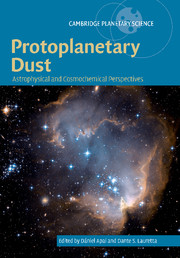Book contents
- Frontmatter
- Contents
- List of contributing authors
- Preface
- Acknowledgments
- 1 Planet formation and protoplanetary dust
- 2 The origins of protoplanetary dust and the formation of accretion disks
- 3 Evolution of protoplanetary disk structures
- 4 Chemical and isotopic evolution of the solar nebula and protoplanetary disks
- 5 Laboratory studies of simple dust analogs in astrophysical environments
- 6 Dust composition in protoplanetary disks
- 7 Dust particle size evolution
- 8 Thermal processing in protoplanetary nebulae
- 9 The clearing of protoplanetary disks and of the proto-solar nebula
- 10 Accretion of planetesimals and the formation of rocky planets
- Appendix 1 Common minerals in the Solar System
- Appendix 2 Mass spectrometry
- Appendix 3 Basics of light absorption and scattering theory
- Glossary
- Index
8 - Thermal processing in protoplanetary nebulae
Published online by Cambridge University Press: 24 February 2010
- Frontmatter
- Contents
- List of contributing authors
- Preface
- Acknowledgments
- 1 Planet formation and protoplanetary dust
- 2 The origins of protoplanetary dust and the formation of accretion disks
- 3 Evolution of protoplanetary disk structures
- 4 Chemical and isotopic evolution of the solar nebula and protoplanetary disks
- 5 Laboratory studies of simple dust analogs in astrophysical environments
- 6 Dust composition in protoplanetary disks
- 7 Dust particle size evolution
- 8 Thermal processing in protoplanetary nebulae
- 9 The clearing of protoplanetary disks and of the proto-solar nebula
- 10 Accretion of planetesimals and the formation of rocky planets
- Appendix 1 Common minerals in the Solar System
- Appendix 2 Mass spectrometry
- Appendix 3 Basics of light absorption and scattering theory
- Glossary
- Index
Summary
Abstract Crystalline silicates around other stars demonstrate that protoplanetary material is often heated or processed. Similarly, primitive Solar System materials (chondrule components, IDPs, Stardust samples, comet grains) provide multiple lines of evidence for repeated dramatic heating events that affected most or all the protoplanetary materials in the first few million years. The existence of such powerful heating events is not predicted or understood from planet-formation models, yet may have had important implications on the status and composition of planetary raw materials. Here we synthesize the astronomical and meteoritic evidence for such events and discuss proposed models. By matching astronomical analogs to events in the young Solar System we attempt to reconstruct a possible scenario for the thermal processing of protoplanetary materials consistent with all evidence. We also highlight details where the astronomical and cosmochemical views are difficult to reconcile and identify key directions for future research.
Crystalline silicates are tracers of high temperatures (<1000 K), yet they are often observed in cool outer regions of protoplanetary disks (>350 K). Their origin is one of the puzzles that offer insights into the thermal evolution of protoplanetary disks. These crystals may have formed in situ in the cold disk in past heating events or may have been mixed outward from the hot inner disk; perhaps both mechanisms played a role. Similarly, once-molten silicate spherules – chondrules – and refractory inclusions delivered from the cold Asteroid Belt (∼180 K) by primitive chondritic meteorites are products of high temperatures. In many chondritic meteorites chondrules account for over 80% of the total mass, revealing that most of the primordial material in the Asteroid Belt, and perhaps elsewhere, has been heated and compacted.
- Type
- Chapter
- Information
- Protoplanetary DustAstrophysical and Cosmochemical Perspectives, pp. 230 - 262Publisher: Cambridge University PressPrint publication year: 2010
- 3
- Cited by

